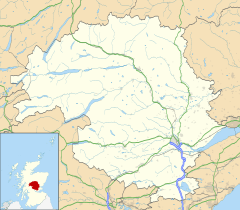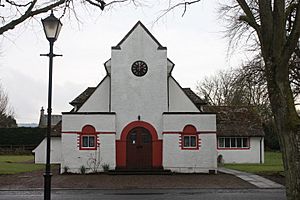Forteviot facts for kids
Quick facts for kids Forteviot |
|
|---|---|
 Houses on the square in Forteviot |
|
| OS grid reference | NO052174 |
| Council area | |
| Lieutenancy area | |
| Country | Scotland |
| Sovereign state | United Kingdom |
| Post town | Perth |
| Postcode district | PH2 |
| Dialling code | 01764 |
| Police | Tayside |
| Fire | Tayside |
| Ambulance | Scottish |
| EU Parliament | Scotland |
| UK Parliament |
|
| Scottish Parliament |
|
Forteviot (Scottish Gaelic: Fothair Tabhaicht) is a small village in Scotland. It is located in an area called Strathearn. You can find it in Perth and Kinross, near the River Earn. It sits between the towns of Dunning and Perth. In 1991, about 160 people lived here.
The village you see today was mostly rebuilt in the 1920s. This was done by a famous person named John Alexander Dewar, 1st Baron Forteviot. His family was well-known for making Dewar's whisky.
Contents
Discovering Ancient Forteviot
A Royal Tomb from the Bronze Age
On August 11, 2009, archaeologists made an exciting discovery. They found a royal tomb in Forteviot. This tomb dates back to the early Bronze Age.
Inside the tomb, they found the remains of an ancient ruler. There were also amazing treasures buried with them. These included a dagger made of bronze and gold. They also found a wooden bowl and a leather bag. Experts from Glasgow University and Aberdeen University are still studying these finds.
The Pictish Palace of Forteviot
Forteviot has a long history. People lived here as far back as the 9th century. A king named Cináed mac Ailpín (also known as Kenneth mac Alpin or Kenneth I of Scotland) is said to have died here. He passed away in his 'palace' in 858.
This old palace used to stand on Haly Hill. This hill is on the west side of the modern village. It overlooked a stream called the Water of Mey.
In the 17th century, you could still see the ruins of a castle. This castle was linked to Máel Coluim III (who ruled from 1058 to 1093).
Ancient Art and Architecture
Several pieces of old medieval sculpture are kept in the local church. This church is dedicated to St Andrew.
A famous piece is the 'Forteviot Arch'. This is a large stone arch from the early 9th century. It has carved figures on it. It was found in an old part of the Water of May. Today, you can see it at the National Museum of Scotland in Edinburgh. It was probably part of a royal chapel long ago.
Modern Forteviot Village
The village was rebuilt in the 1920s. It was designed to be a "model village." The architect, James Miller, followed instructions from John Dewar, 1st Baron Forteviot. The design was inspired by the Garden City movement.
The village hall is a very interesting building. It sits across from the main village square. It shows a unique style from the 1920s. It is considered a very important historic building.
The current church building is from 1778. It looks like a simple Georgian chapel. However, the church itself has been there since the 13th century. Some gravestones in the churchyard date back to 1690.
Notable People from Forteviot
- Very Rev John Inglis, a well-known church leader, was born in the Forteviot manse (the minister's house).




